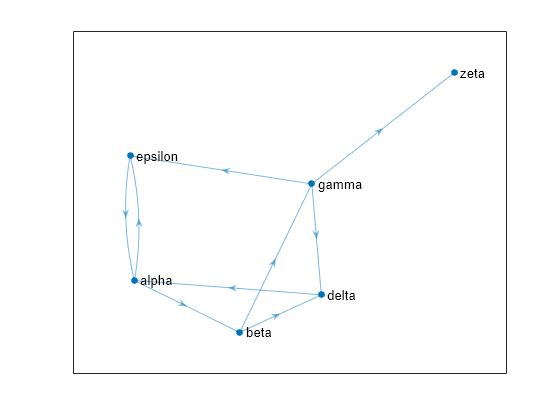centrality
衡量节点的重要性
说明
示例
创建并绘制一个包含六个虚拟网站的图。
s = [1 1 2 2 3 3 3 4 5];
t = [2 5 3 4 4 5 6 1 1];
names = {'http://www.example.com/alpha', 'http://www.example.com/beta', ...
'http://www.example.com/gamma', 'http://www.example.com/delta', ...
'http://www.example.com/epsilon', 'http://www.example.com/zeta'};
G = digraph(s,t,[],names);
plot(G,'NodeLabel',{'alpha','beta','gamma','delta','epsilon','zeta'})
使用 centrality 函数计算每个网站的网页排名。将此信息作为图节点的一个属性追加到图的 Nodes 表中。
pg_ranks = centrality(G,'pagerank')pg_ranks = 6×1
0.3210
0.1706
0.1066
0.1368
0.2008
0.0643
G.Nodes.PageRank = pg_ranks; G.Nodes
ans=6×2 table
Name PageRank
__________________________________ ________
{'http://www.example.com/alpha' } 0.32098
{'http://www.example.com/beta' } 0.17057
{'http://www.example.com/gamma' } 0.10657
{'http://www.example.com/delta' } 0.13678
{'http://www.example.com/epsilon'} 0.20078
{'http://www.example.com/zeta' } 0.06432
还可以使用 centrality 确定哪些节点是枢纽节点和权威节点,并将得分追加到 Nodes 表中。
hub_ranks = centrality(G,'hubs'); auth_ranks = centrality(G,'authorities'); G.Nodes.Hubs = hub_ranks; G.Nodes.Authorities = auth_ranks;
G.Nodes
ans=6×4 table
Name PageRank Hubs Authorities
__________________________________ ________ __________ ___________
{'http://www.example.com/alpha' } 0.32098 0.24995 7.3237e-05
{'http://www.example.com/beta' } 0.17057 0.24995 0.099993
{'http://www.example.com/gamma' } 0.10657 0.49991 0.099993
{'http://www.example.com/delta' } 0.13678 9.1536e-05 0.29998
{'http://www.example.com/epsilon'} 0.20078 9.1536e-05 0.29998
{'http://www.example.com/zeta' } 0.06432 0 0.19999
使用随机稀疏邻接矩阵创建并绘制一个加权图。由于有很多边,请使用非常小的 EdgeAlpha 值使边几乎透明。
A = sprand(1000,1000,0.15); A = A + A'; G = graph(A,'omitselfloops'); p = plot(G,'Layout','force','EdgeAlpha',0.005,'NodeColor','r');

计算每个节点的度中心性。使用边权重指定每条边的重要性。
deg_ranks = centrality(G,'degree','Importance',G.Edges.Weight);
根据节点的中心性得分,使用 discretize 将节点放入 7 个等间距 bin 中。
edges = linspace(min(deg_ranks),max(deg_ranks),7); bins = discretize(deg_ranks,edges);
使每个节点在绘图中的大小与其中心性得分成正比。每个节点的标记大小等于 bin 编号 (1-7)。
p.MarkerSize = bins;

加载 minnesota.mat 中的数据,其中包含代表明尼苏达州道路网络的图对象 G。图节点具有 xy 坐标,这些坐标包含在 G.Nodes 表的 XCoord 和 YCoord 变量中。
load minnesota.mat
xy = [G.Nodes.XCoord G.Nodes.YCoord];在图中添加与道路长度(使用每条边的端节点的 xy 坐标之间的欧几里德距离计算得出)大致对应的边权重。
[s,t] = findedge(G); G.Edges.Weight = hypot(xy(s,1)-xy(t,1), xy(s,2)-xy(t,2));
使用节点的 xy 坐标绘图。
p = plot(G,'XData',xy(:,1),'YData',xy(:,2),'MarkerSize',5); title('Minnesota Road Network')

计算每个节点的接近中心性。调整节点颜色 NodeCData,使其与中心性得分成正比。
ucc = centrality(G,'closeness'); p.NodeCData = ucc; colormap jet colorbar title('Closeness Centrality Scores - Unweighted')

还要计算加权的接近中心性得分(使用边权重作为遍历每条边的成本)。使用道路长度作为边权重可以提高得分质量,因为距离现在等于遍历的所有边的长度总和,而不是遍历的边数。
wcc = centrality(G,'closeness','Cost',G.Edges.Weight); p.NodeCData = wcc; title('Closeness Centrality Scores - Weighted')

计算图的加权中间中心性得分,以确定在两个节点之间的最短路径上出现频率最高的道路。使用因子 对中心性得分进行归一化,以使得分表示旅行者沿两个随机节点之间的最短路径经过给定节点的概率。该绘图表明进出这座城市有几条非常重要的道路。
wbc = centrality(G,'betweenness','Cost',G.Edges.Weight); n = numnodes(G); p.NodeCData = 2*wbc./((n-2)*(n-1)); colormap(flip(autumn,1)); title('Betweenness Centrality Scores - Weighted')

输入参数
节点中心性的类型,指定为下表中的选项之一。表中还列出了适用于每个类型的兼容的名称-值参量。每个节点中心性变体为衡量节点在图中的重要性提供了一种不同的方法。
| 选项 | 图类型 | 描述 | 名称-值参量 |
|---|---|---|---|
|
| 无向 |
如果指定 | |
|
| 有向 | ||
|
| 无向 |
Ai 是可从节点
| |
|
| 有向 | ||
|
| 无向或有向 |
是从
| |
|
| 无向或有向 |
| |
|
| 无向 |
| |
|
| 有向 |
|
注意
centrality 函数假定所有边权重都等于 1。要更改此设置,请指定边权重与 'Cost' 或 'Importance' 名称-值对组一起使用。
示例: centrality(G,'degree')
示例: centrality(G,'hubs','Tolerance',tol)
名称-值参数
以 Name1=Value1,...,NameN=ValueN 的形式指定可选参量对组,其中 Name 是参量名称,Value 是对应的值。名称-值参量必须出现在其他参量之后,但对各个参量对组的顺序没有要求。
在 R2021a 之前,使用逗号分隔每个名称和值,并用引号将 Name 引起来。
示例: C = centrality(G,'closeness','Cost',edgeCosts) 使用 edgeCosts 作为遍历图中每条边的成本(权重)来计算接近中心性。
遍历边的成本,以逗号分隔的对组形式指定,包含 'Cost' 和一个边权重向量。第 i 个边权重指定与遍历边 findedge(G,i) 相关的成本。
对于
'closeness'、'outcloseness'和'incloseness'中心性类型,边成本必须为非负值。对于
'betweenness'中心性类型,边成本必须为正值。
连接越短、越快或者成本越低,'Cost' 边权重就越小。'Cost' 边权重的一些示例包括:
旅程长度
差旅时间
机票成本
注意
'Cost' 仅适用于 'closeness'、'outcloseness'、'incloseness' 和 'betweenness' 中心性类型。
示例: centrality(G,'closeness','Cost',c)
选择后继节点的概率,以逗号分隔的对组形式指定,包含 'FollowProbability' 和一个介于 0 和 1 之间的标量。下面的概率是 PageRank 算法在遍历过程中从当前节点的后继节点中选择下一个节点的概率,而不是从所有节点中随机选择下一个节点的概率。对于网站,此概率指点击当前网页上的某个链接而不是浏览到另一个随机网页的概率。
注意
'FollowProbability' 仅适用于 'pagerank' 中心性类型。
示例: centrality(G,'pagerank','FollowProbability',0.5)
边的重要性,以逗号分隔的对组形式指定,包含 'Importance' 和一个非负的边权重向量。第 i 个边权重指定边 findedge(G,i) 的重要性。边权重为零相当于从图中删除这条边。
对于两个节点之间具有多条边的多重图,centrality 会将多条边相加,将它们视为具有合并权重的单条边。
连接越强,'Importance' 边权重越大。'Importance' 边权重的一些示例包括:
每天的旅行人数
链接的点击次数
发表的论文总数
注意
'Importance' 仅适用于 'degree'、'outdegree'、'indegree'、'pagerank'、'eigenvector'、'hubs' 和 'authorities' 中心性类型。
示例: centrality(G,'degree','Importance',x)
最大迭代数,指定为以逗号分隔的对组,包含 'MaxIterations' 和一个标量。centrality 算法一直运行到满足容差或达到最大迭代次数为止,以先出现者为准。
注意
'MaxIterations' 仅适用于 'pagerank'、'eigenvector'、'hubs' 和 'authorities' 中心性类型。
示例: centrality(G,'pagerank','MaxIterations',250)
迭代求解器的停止条件,指定为以逗号分隔的对组,包含 'Tolerance' 和一个标量。centrality 算法一直运行到满足容差或达到最大迭代次数为止,以先出现者为准。
注意
'Tolerance' 仅适用于 'pagerank'、'eigenvector'、'hubs' 和 'authorities' 中心性类型。
示例: centrality(G,'pagerank','Tolerance',1e-5)
输出参量
节点中心性得分,以列向量形式返回。C(i) 是节点 i 的中心性得分。对节点中心性得分的解释取决于所选的中心性计算类型。节点距离中心越近,其中心性得分越高。
扩展功能
基于线程的环境
使用 MATLAB® backgroundPool 在后台运行代码或使用 Parallel Computing Toolbox™ ThreadPool 加快代码运行速度。
版本历史记录
在 R2016a 中推出
MATLAB Command
You clicked a link that corresponds to this MATLAB command:
Run the command by entering it in the MATLAB Command Window. Web browsers do not support MATLAB commands.
选择网站
选择网站以获取翻译的可用内容,以及查看当地活动和优惠。根据您的位置,我们建议您选择:。
您也可以从以下列表中选择网站:
如何获得最佳网站性能
选择中国网站(中文或英文)以获得最佳网站性能。其他 MathWorks 国家/地区网站并未针对您所在位置的访问进行优化。
美洲
- América Latina (Español)
- Canada (English)
- United States (English)
欧洲
- Belgium (English)
- Denmark (English)
- Deutschland (Deutsch)
- España (Español)
- Finland (English)
- France (Français)
- Ireland (English)
- Italia (Italiano)
- Luxembourg (English)
- Netherlands (English)
- Norway (English)
- Österreich (Deutsch)
- Portugal (English)
- Sweden (English)
- Switzerland
- United Kingdom (English)